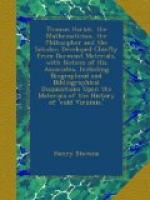What the Earl of Northumberland did for Hariot is, as the world goes, ascribed to patronage ; what Hariot did for the Earl cannot be measured by money or houses, but may be summed up in four words, alike honorable to both, ’ they were long friends.’ To this day the debt of gratitude from the philosopher to the nobleman is fairly balanced by the similar debt of the nobleman to the philosopher. Hariot’s Will, given on pages 193-203, tells the rest of the story of this noble friendship.
It is manifest, however, from many considerations that the noble Earl took a lively and almost officious interest in the public honor and character of his friend, for Hariot appears to have been as careless of his own scientific reputation as his contemporary Shakspeare is said to have been of his literary eminence.
On the other hand, Hariot’s interest in the Earl’s affairs and family at Sion redound greatly to his credit. He was both an eminent scholar and a remarkable teacher. Earnest students flocked to him for higher education from all parts of the country. Besides the private scientific and professional instruction that from the first he gave to Raleigh, his captains and sea officers, he seems to have had under his scientific tuition and mathematical guidance many young men who afterwards became celebrated; among whom may be mentioned Robert Sidney, the brother of Sir Philip, afterwards Lord Lisle of Penshurst; Thomas Aylesburyof Windsor, afterwards Sir Thomas, the great-grandfather of two queens of England; the late Lord Harrington; Sir William Protheroe and Sir William Lower of South Wales; Nathaniel Torporley of Shropshire; Sir Ferdinando Gorges of Devonshire; Captain Keymis; Captain Whiddon, and many others. Cordial and affectionate letters of most of these men to their venerated master are still preserved.
At Sion were the groves of Hariot’s academy.
Yet he with Warner and Hues was constantly passing by the Thames between Sion and the Tower, some three or four hours by oar and tide. They were all three pensioners, or in the pay, of the Earl, though the last two were on a very different footing from that of Hariot as to emoluments and responsible position. They were, however, companions of both the Earl and Sir Walter, and, if tradition is to be believed, they were sometimes joined by Ben Jonson, Dr Burrill, Rev. Gilbert Hawthorne, Hugh Broughton, the poet Hoskins and perhaps others.




